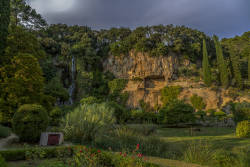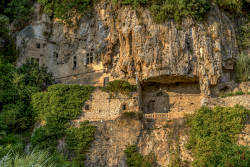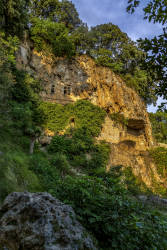Grottes et Cascade de Villecroze
Villecroze Caves
Useful Information

| Location: |
Grottes et Cascade de Villecroze, Gorges du Verdon, Var.
8 km from Aups and 24 km from Bauduen. 15 km west of Draguignan on the D557, or 40 km south of Moustiers-Ste-Marie (D957) and 8 km southeast of Aups on the D557. (43.584733, 6.277721) |
| Open: |
Park: All year daily during daylight hours. Caves: APR to JUN Wed-Sun 13-17. JUL to AUG daily 10-17. SEP Tue-Sun 10-12, 14-17. OCT Wed-Sun 13-16. [2020] |
| Fee: |
Adults EUR 4, Children (6-11) free, Children (0-5) not allowed. Groups (10+): Adults EUR 3. [2020] |
| Classification: |
 Cave Castle Cave Castle
 Tufa cave Tufa cave
 Primary cave Primary cave
|
| Light: |
 Incandescent Incandescent
|
| Dimension: | |
| Guided tours: |
self guided.
D=20 min.
Text in


|
| Photography: | Allowed, but no flash. |
| Accessibility: | No, many stairs, stooping |
| Bibliography: |
Anonymous (nY):
Les Grottes Troglodytiques de Villecroze, Var
available from the Tourist Office and the Caves for the price of 2€
|
| Address: |
Information: Mairie, Tel: +33-494-706306.
Bureau d’Information Touristique de Villecroze (Villecroze Tourist Office), 12 rue Ambroise Croizat, 83690 Villecroze, Tel: +33-494-675000. E-mail: |
| As far as we know this information was accurate when it was published (see years in brackets), but may have changed since then. Please check rates and details directly with the companies in question if you need more recent info. |
|
History
| Prehistoric | this is a Neolithic site, and there are many finds in the local museum. |
| 1065 | first reference, Castrum de villa Crosa. |
| 1566 | caves fortified by Nicolas d’Albertas. |
| 1633 | ownership of the caves ceded to the commune of Villecroze. |
| 1924 | declared a Natural Monument. |
Description


The town Villecroze is located in a flat and fertile valley, at the foot of a barren limestone hill. At the far end of the village, below the limestone cliffs, lies a strange and romantic place named Parc Floral Municipal. This beautiful spot with nicely shaped plants, trails and benches, is a municipal park which could be found in many villages. But the white cliffs at the northern side are exceptional.
The cliffs contain numerous caves, named Grottes Troglodytes which means "cave-dwellers caves" - obviously a  tautology, or at least a pleonasm.
The cliffs consist of travertine, also named sweet-water limestone or tufa, which is limestone deposited by limestone rich karst water.
When it reaches the surface and looses its carbon dioxide content rather fast the limestone is precipitated.
The carbon dioxide was responsible for the ability of the water to dissolve limestone, without it the water cannot hold the limestone.
Because of plant growth (which adds to the carbon dioxide consumption) the limestone is rather porous.
The plants are covered by limestone crusts, then die and decompose, leaving a small hole in the limestone.
This is easy to see at the porous limestone cliffs.
tautology, or at least a pleonasm.
The cliffs consist of travertine, also named sweet-water limestone or tufa, which is limestone deposited by limestone rich karst water.
When it reaches the surface and looses its carbon dioxide content rather fast the limestone is precipitated.
The carbon dioxide was responsible for the ability of the water to dissolve limestone, without it the water cannot hold the limestone.
Because of plant growth (which adds to the carbon dioxide consumption) the limestone is rather porous.
The plants are covered by limestone crusts, then die and decompose, leaving a small hole in the limestone.
This is easy to see at the porous limestone cliffs.
A 40 m high waterfall cascades down the front of the cliffs on the left side. This is the water responsible for the formation of the tufa deposit. The deposit is rather young, in geologic terms, but not recent. It was formed 700,000 years ago, when probably much more water was flowing down the brook forming a series of waterfalls.
High in the cliffs are a group of small natural caves, which were formed by the irregular growth of the limestone. Some of those caves were transformed into dwellings, cave houses, which overlook the medieval village. This happened during the Middle Ages. The local Lord, Nicolas d’Albertas, decided in 1566 to built a fortification into the natural caves. They had enormous strategic benefits, it was only necessary to defend the front side, as the rest was surrounded by massive rock. And the rock was soft enough to make the construction much easier. The rock hewn out to create passages was immediately used to build walls and staircases. However, nothing happened and the town was never under attack or besieged. The fortification were thus never needed, and after many years - in 1633 - Nicolas d’Albertas ceded ownership of the caves to the commune of Villecroze.
The front rooms were formed by closing overhanging cliffs with walls, and are lighted from windows facing out across to the village. Arched openings with staircases lead into the natural caves behind, which show the typical structures of the tufa and also some stalactites and other speleothems. The massive human alterations of the originally natural caves are the reason why we classified this as artificial caves. The caves were originally quite small, it seems the main reason to built a castle were not the caves but the softness of the rock, which made the excavations quite easy. But when the tufa was used to built walls, it dried out and became quite hard. The caves are entered through a door on the left side of the terrace with the walls. Inside is a large room where the ticket seller explains the caves in French and English.
- See also
 Search DuckDuckGo for "Grottes et Cascade de Villecroze"
Search DuckDuckGo for "Grottes et Cascade de Villecroze" Google Earth Placemark
Google Earth Placemark Troglodytic Caves : a little history... (visited: 19-DEC-2020)
Troglodytic Caves : a little history... (visited: 19-DEC-2020) La grotte de Villecroze (83) – Tuf tuf (visited: 20-DEC-2020)
La grotte de Villecroze (83) – Tuf tuf (visited: 20-DEC-2020) Villecroze Grotto visit by Provence Beyond (visited: 10-SEP-2014), detailed description of the caves.
Villecroze Grotto visit by Provence Beyond (visited: 10-SEP-2014), detailed description of the caves. Der Park und die Grotten von Villecroze
Der Park und die Grotten von Villecroze  (visited: 20-DEC-2020)
(visited: 20-DEC-2020)
 Index
Index Topics
Topics Hierarchical
Hierarchical Countries
Countries Maps
Maps